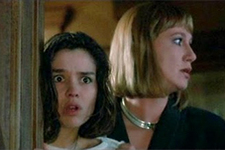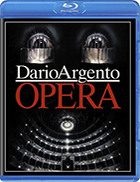Opera
|  The story goes that Italian horror director Dario Argento often complained that viewers would shut their eyes during the goriest parts of his films. As most of his stories revolve around psychopathic masked killers, Argento has supplied over the years plenty of gory sights at which one might feel compelled to close one’s eyelids, including Deep Red (Profondo Rosso, 1975), Suspiria (1977), and Inferno (1980). Thus, for Opera (1987), his 10th film and arguably his last to brush against greatness, Argento devised what is perhaps the most disturbing and inherently self-reflexive image of his entire oeuvre: a woman tied to a pole with her mouth taped shut and her eyes forced open by a row of straight pins taped just beneath her eyes. In Argento’s own words, Opera is the most ferocious movie he’s ever done, and this single image conveying the inability to close one’s eyes and shut out the horror before them is an apt metaphor for the terrible pleasures of horror movies themselves—they’re unwatchable, yet we watch anyway. It is the captive audiencehorrifically literalized. As Argento’s films, particularly those in the 1970s and ’80s, have often been described as operatic—each one an exercise in baroque stylistic theatrics and emotional excess—it is only logical that he would eventually set one of his horror-thrillers within the opera world. With its grand scale and brooding themes, the art of opera fits neatly with Argento’s lavish stylistics and dark preoccupations as a filmmaker. He gets at this connection rather amusingly by having the central opera in his film—Giuseppe Verdi’s Macbeth—helmed by a horror movie director who turns the performance into an elaborate avant-garde excursion into the darkest realms of humanity, with the stage transformed into a war-torn battlefield packed with dozens of squawking black ravens and overlooked by a giant skull (interestingly, in an episode of art-imitating life-imitating art, Argento went on to stage Verdi’s Macbeth for real in 2013 in a manner quite similar to the fictitious staging in Opera). Argento inserts even more self-reflexive commentary by having the director be accused of being a sadist (something Argento has been called on more than one occasion, especially in regards to his on-screen treatment of women). He also gives the director a great line that plays as a none-too-subtle jab at all those who try to link violent movies with violence in real-life: “I think it is unwise to use movies as a guide for reality.” The response to this line—“Depends on whose reality”—says just as much. Conveniently for the plot, legend has it that Verdi’s Macbeth is a cursed opera that brings bad luck to whoever performs it. This appears to be the case, as, within the opening moments of the film, the egotistical diva playing the role of Lady Macbeth is struck by a car, and her young, but extremely talented understudy, Betty (Cristina Marsillach), is given the role. Betty is understandably concerned about the opera’s curse and worried about her ability to fill the leading role, but, as the old saying goes, the show must go on. Betty soon discovers firsthand that the curse is indeed true, as it is she who ends up bound with pins taped beneath her eyes, forced to watch a man in a black hood and black leather gloves murder those around her one by one. A sympathetic police inspector (Urbano Barberini) doesn’t seem to be of much help, and Betty’s closeness to both Urbano (William McNamara), a handsome stagehand, and Marco (Ian Charleson), the horror-turned-opera director, only puts them in potential danger. The narrative waters are further muddied by the fact that the black-hooded slasher is reminiscent of a specter that haunts Betty’s dreams, which may be repressed memories of past events. As with most of Argento’s work, the story is a bit convoluted, although not nearly as much as some of his other films (Argento penned the screenplay from a story he concocted with the prolific Franco Ferrini, with whom he previously collaborated on 1985’s Phenomena and Demons). Argento does devise several cunning scenarios, including one in which Betty and her friend Mira (Daria Nicolodi) are in Betty’s apartment with one man inside and one man outside, either one of whom may be the killer. Yet, in the end, the mystery of the killer’s identity is really secondary to the lavish style and gory details that have long been Argento’s directorial signature—openly emulated, but never equaled by scores of other would-be horror maestros. Whether it be a shot of a feather pillow exploding on the pavement after being dropped from the top of a building, or an extreme close-up of a bullet ripping through the peephole of a door in slow motion, Argento knows how to squeeze every bit of excitement out of his imagery, no matter how banal or bizarre. By staging his story in the world of opera, Argento skillfully uses the excesses of stage design, costumes, and the enormous, golden-hued Teatro Regio di Parma to give his film added scope and grandeur. He and cinematographer Ronnie Taylor, who worked with Richard Attenborough on Gandhi (1982), A Chorus Line (1985), and Cry Freedom (1987), devise elaborate and exhilarating camera movements, from tense chase sequences shot from extreme low angles, to the stunning climatic scene that spins around the Parma theater from a raven’s point of view as the bird swoops about looking for the murderer. It is too bad that Argento felt the need to tack on a second climax at the end of the film, moving the action to the Swiss Alps in a sequence that plays like some kind of deranged parody of The Sound of Music (1965). It is an unfortunate move on his part, as it tacks a decidedly silly conclusion onto what was otherwise a solid shocker, a gory thriller of operatic intensity imminently worthy of its title.
Copyright © 2018 James Kendrick Thoughts? E-mail James Kendrick All images copyright © Scorpion Releasing | |||||||||||||||||||||||||||||||
Overall Rating: 


 (3.5)
(3.5)


